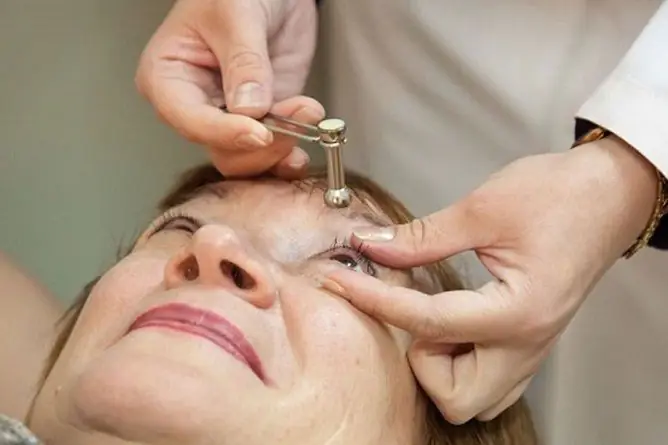- Author Rachel Wainwright [email protected].
- Public 2023-12-15 07:39.
- Last modified 2025-11-02 20:14.
5 ways to lower your fever without medication
High fever is a common symptom of such common diseases as ARVI, tonsillitis, pneumonia. To reduce fever and relieve the patient's condition, doctors recommend taking antipyretic drugs, but this is not always possible. Too frequent use of these drugs can lead to allergic reactions and overdose - poisoning. It also happens that antipyretics are simply not in the house. In such situations, it is worth using non-drug, but therefore no less effective ways to lower the temperature. Here are a few of them.
Rubdown
To reduce the patient's temperature, moisten a sponge or towel in cool water, squeeze and gently wipe the torso, face, and limbs. The droplets of liquid remaining on the skin are allowed to dry on their own. To enhance the effect, add a few drops of vinegar or vodka to the water in a 1: 1 ratio. It is better to wipe children with water at room temperature (otherwise, the procedure can provoke shock and febrile convulsions caused by vasospasm).
The procedure for wiping with water, even water at room temperature, has the effect of reducing the heat by 1-2 degrees for 1-1.5 hours.

Source: depositphotos.com
Applying ice
To reduce the temperature, ice is split into small pieces, folded into a plastic bag and applied to the projection sites of large vessels: to the forehead, to the axillary areas, inguinal folds, popliteal fossa. To protect the patient from hypothermia, a rolled cotton towel should be placed between the skin and the ice. It is better not to continue applying ice for more than 5-7 minutes; after a quarter of an hour, the procedure can be repeated.

Source: depositphotos.com
Cool enema
An antipyretic enema is an unpleasant procedure that is recommended if all other ways to lower the temperature are unacceptable or have not yielded tangible results. For these purposes, warm water is used, as a rule, 2 degrees lower than the body temperature at the moment, with salt (at the rate of ½ tsp. Per 100 ml of water). The amount of liquid for an enema depends on the age of the patient:
- 1 year - 120 ml;
- 2 years - 200 ml;
- 5 years - 500 ml;
- over 10 years old - 1 liter.
All of the above physical methods of lowering body temperature (wiping, applying ice, enema) are contraindicated in children under one year old - especially with a tendency to seizures, heart defects. In addition, these procedures should not be used for cold hyperthermia (chills, icy limbs, bluish skin color) - in this case, they will only aggravate the patient's condition.

Source: depositphotos.com
Drinking plenty of fluids
Drinking plenty of fluids at high body temperature is recommended so that the patient has something to perspire - and sweat is known to have a high cooling effect. With this drinking regime, the elimination of toxins is activated, and the reserves of fluid lost during sweating are replenished in time. When treating ARVI, it is recommended to consume drinks rich in vitamin C: a decoction of rose hips, dried fruits, cranberry juice, tea with lemon, orange juice. Tea with raspberry jam and other antipyretics will increase sweating, but you should drink something else before using it. Drinks should be taken slowly, in small sips, so as not to induce vomiting. If you feel hot, the drink should be warm (about 30 ° C), and if you chill, it should be hot. In order for the body to have somewhere to give off heat, the air in the room must be cool (no more than 18 ° C).

Source: depositphotos.com
Natural antipyretics (antipyretics)
Natural antipyretics are fruits and plants with antipyretic properties.
The first group of such plants contains salicylic acid, which is part of aspirin, only in a lower concentration. These are strawberries, raspberries, cherries, black and red currants, prunes, oranges. You can eat berries and fruits in any form, but it is better as fruit drinks and jam added to tea.
The second group of antipyretics - plants with diaphoretic effect: oregano, birch buds, calendula, linden blossom. It is better to prepare a decoction of them: 2 tbsp. l. dry raw materials pour 200 g of boiling water and leave for 2 hours.
Ordinary honey is also an antipyretic, and it contains salicylic acid and has a diaphoretic effect. Moreover, honey strengthens the immune system, thus providing antibacterial and antiviral effects.
Any natural antipyretics should be used with caution, as they can all cause allergies.

Source: depositphotos.com
And in conclusion, it should be noted that the reduction of fever with non-drug means is allowed as emergency measures or in the case of persistent hyperthermia that does not respond to drugs. However, a decrease in temperature does not exclude a visit to a doctor for prescribing treatment.
YouTube video related to the article:

Maria Kulkes Medical journalist About the author
Education: First Moscow State Medical University named after I. M. Sechenov, specialty "General Medicine".
Found a mistake in the text? Select it and press Ctrl + Enter.






